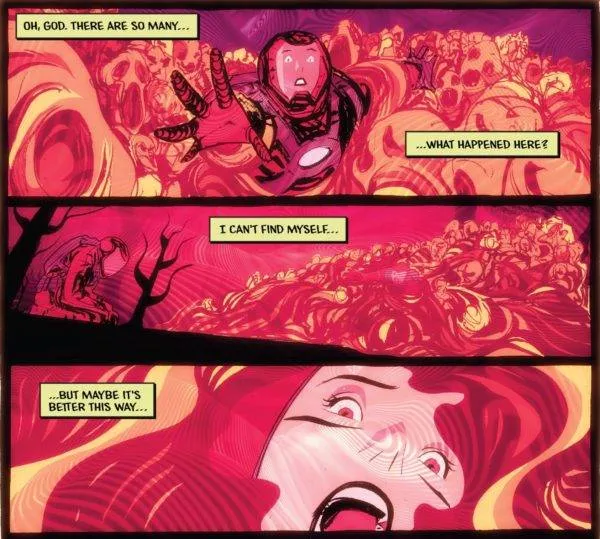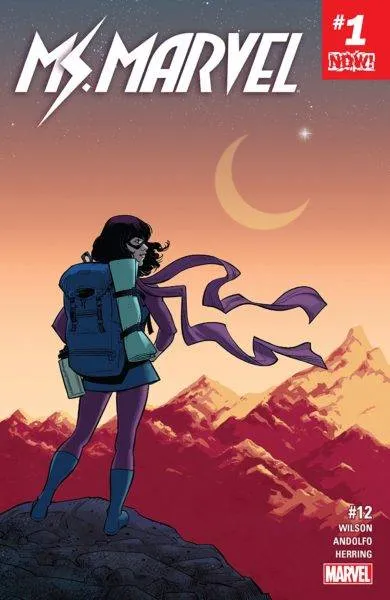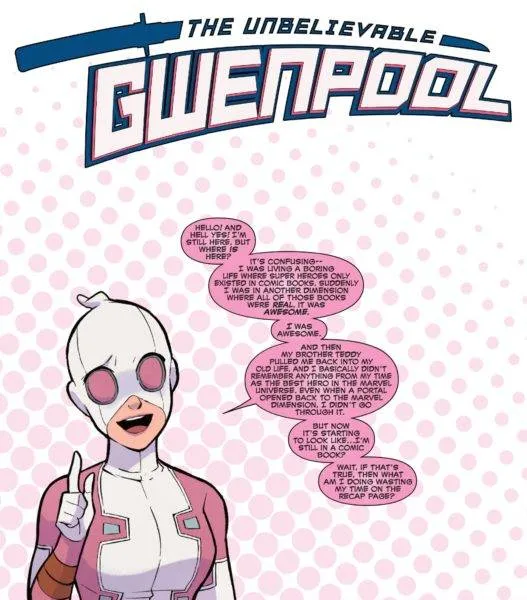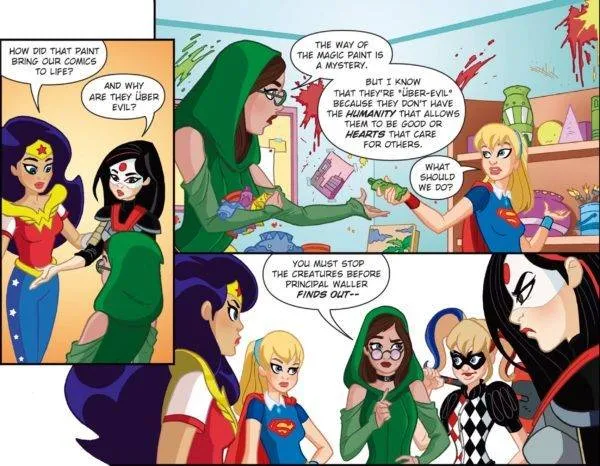
Forget Jumping On, Just Dive In: An Experiment
Nearly every weekend when I was a kid, my parents and I would take the Long Island Railroad to visit my grandparents. Amid the storm of anxiety that was my mother (who despite meticulously calculating how much time was required to ensure we would not only make the train on time, but also have a nice cushion to gather provisions) these weekend jaunts elicited a focused excitement in me because it also meant I’d get to pick out new comics to read for the thirty minute trip. In the catacombs of Penn Station, I’d scour the shelves of whatever local newsstand was by our track number and get to choose between maybe a dozen or so titles. That’s right kids, comics at newsstands. Wild, I know. Obviously, it’s not like these periodical purveyors carried back issues of titles or would even have the same titles available one week to the next. Which meant one thing: I had to just dive in regardless of what issue number a comic series was on or if I had ever even read the series before.
In the modern era of comic books, we talk a lot about how they’re more decompressed than they once were and that they are structured specifically for being collected into collected editions; “writing for the trade” as it were. With many of us programmed to consume our favorite media in this age of Netflix, we’re used to having everything available to us all at once. The rise of digital comics provides us with archives of virtually every issue of every title just a click away. Like many, the thought of just starting a story anywhere but the very beginning isn’t just verboten, it’s downright paralyzing. Considering that many comic book readers of a certain age (look, I’m old, okay?) started reading comics by just picking up whatever was available, it’s interesting to me that replicating that same strategy now is a hard no-go. If you’re like me, there was a certain thrill to just joining a story already in progress and getting lost in all the ephemera of what seemed like an entire universe teeming with existing wonders. Often, thanks to additions like editor’s note caption boxes, it prompted me to specifically go out and hunt down these living documents of fictional history. Getting overwhelmed led to getting obsessed with knowing more. Now? I’m not committing unless I’m getting everything up front, I’ll be damned if I don’t know every detail of what’s going on. My control issues are fine, why do you ask?
 “Every comic book is someone’s first” is an adage commonly attributed to Stan Lee and it feels like that’s something we all assume has fallen by the wayside, for better or worse. There’s been plenty of times while reading an issue of a run I’ve been with since the beginning where I thought, “Hell, I can’t imagine someone picking this up and having any clue what’s happening here.” A frequent refrain from would-be readers is that starting a series with a high number is intimating, which in turn is also partially responsible for the now never-ending renumbering of titles. In fact, Marvel just started plastering large #1’s on issues that weren’t even number one issues to indicate that specific issues were good “jumping-on” points. There are plenty of barriers for new comic readers, but not knowing where to start is one of the biggest.
“Every comic book is someone’s first” is an adage commonly attributed to Stan Lee and it feels like that’s something we all assume has fallen by the wayside, for better or worse. There’s been plenty of times while reading an issue of a run I’ve been with since the beginning where I thought, “Hell, I can’t imagine someone picking this up and having any clue what’s happening here.” A frequent refrain from would-be readers is that starting a series with a high number is intimating, which in turn is also partially responsible for the now never-ending renumbering of titles. In fact, Marvel just started plastering large #1’s on issues that weren’t even number one issues to indicate that specific issues were good “jumping-on” points. There are plenty of barriers for new comic readers, but not knowing where to start is one of the biggest.
 So, I decided to perform an experiment. Wanting to replicate that same sense of anticipation of the unknown that I felt staring at the newsstand rack in Penn Station, I decided that for the June 14th new comic releases, I would intentionally purchase random comics to see how accessible they really were. I can hear the sound of your monocles shattering as you read that.
I’m not a scientist, but I’m pretty sure I needed to have some sort of criteria for this experiment, so I decided on the following:
So, I decided to perform an experiment. Wanting to replicate that same sense of anticipation of the unknown that I felt staring at the newsstand rack in Penn Station, I decided that for the June 14th new comic releases, I would intentionally purchase random comics to see how accessible they really were. I can hear the sound of your monocles shattering as you read that.
I’m not a scientist, but I’m pretty sure I needed to have some sort of criteria for this experiment, so I decided on the following:

WORLD READER #3 by Jeff Loveness, Juan Doe, and Rachel Deering

MS. MARVEL #1 err…#12, actually. (Cover by Cameron Stewart)
- Pick an issue from a series that I have not read in its current incarnation (i.e. with current creative team, since a reboot, etc.)
- It cannot be a #1 issue or the first part of a new storyline
- At least one all-ages title
Using those as a guide, I scanned the latest releases and told myself, “Okay, train’s coming. Pick something and go.”
In the end, I wound up with nine comics that adhered to my criteria: Betty & Veronica #3, Optimus Prime #8, Dragon Age: Knight Errant #2, The Unbelievable Gwenpool #17, World Reader #3, Action Comics # 981, Birthright #25, DC Superhero Girls #5, and The Sovereigns #2. These nine were largely picked arbitrarily with the exception of Action Comics, which I made sure to include because it was the highest numbered comic released that Wednesday.
Upon finishing the last of the nine issues, I was legitimately surprised by my experience. I’ll spare you mini-reviews of each individual title since I wasn’t really reading them to assess them as full works so much as I was simply trying to gauge how well they matched my childhood “dive in” experiences, but suffice to say the majority of them were far more accessible than I had expected. It probably doesn’t need to be stated, but for posterity’s stake, the following is all super subjective.
Of the nine, only three had recap pages: Gwenpool, Optimus Prime, and Betty & Veronica. Why every comic doesn’t do this is beyond me; more than just condensing the story thus far, recap pages can often distill the tone of the book, something Gwenpool did with aplomb. Of the remaining six, three provided relatively easy transitions into an existing story: World Reader, Dragon Age, and The Sovereigns. The remaining three (Action Comics, DC Superhero Girls, and Birthright) all basically throw you into the deep end of the pool right off the bat.
 The only truly impenetrable title was the creator-owned, Birthright. To be clear, that’s not a knock on its quality, but rather an expected outcome considering that it simply isn’t designed to be accessible at this stage of its existence. It has a built-in audience since it launched in 2014 and maintains its monthly sales while hoping others will jump aboard after picking up the trades. It also doesn’t feature pre-existing characters that live in the pop culture zeitgeist. Of the issues I purchased, it is the best example of the aforementioned “writing for the trade” methodology. That being said, I was lost as hell and not much of what I read made me particularly curious to learn more about this world, which is something I can’t say for all the other titles I read.
Real talk: The Unbelievable Gwenpool is phenomenal. Nothing surprised me more than this, so much so that I readily went back to pick up its preceding sixteen issues. This was part two of an existing arc, but it clearly conveyed who its titular character is and the overall tones and themes that it didn’t matter one iota. It was honestly hard to believe that a full sixteen issues came out before this one. This was a title I initially presumed I would have no interest in and yet it was exactly the experience I was hoping to recreate and in turn, this series now has one new devoted fan.
With Gwenpool as my ceiling and Birthright as my floor, all the others fell comfortably in-between with World Reader, Dragon Age, and Betty & Veronica all being pleasant surprises. Betty & Veronica’s whole deal is basically in the title and combined with its really tight recap, it was an absolute pleasure to read. It felt wholly contained as a satisfying one issue read, the kind that you hear creators’ talk about all the time (i.e. “We try to make sure readers get their money’s worth out of each individual issue”) but so rarely deliver on. World Reader’s haunting atmosphere and tension created the sort of ambiguity that I typically enjoy in many a first issue, so the third issue left me with a similar amount of questions that I’ve had after reading some first issues. Dragon Age would likely have been an even more fulfilling read if I was in any way, shape, or form familiar with the franchise’s existing lore, but I still found myself comfortably aground in what felt like something with real mythological history. I’m definitely not the target audience for DC Superhero Girls, but I still appreciated its charm. It may very well have started right in the middle of the action, but it’s not as though piecing together the events was any more difficult than catching a random episode of a children’s cartoon. All-ages books like this one smartly reincorporate and restate past events and character relationships into the present narrative often and just subtly enough that I can easily see a kid pointing at any random issue with its fun characters on the cover and just starting right there. Optimus Prime and Action Comics are probably the hardest to assess, largely because of my existing familiarity with the franchises regardless of whether or not I’ve read either comic in years. It was very easy to just start following along and each convincingly conveyed the larger scope of their stories’ well, but if the concept of a Cyborg Superman or Cybertronian politics are basically Greek to you, then I can see feeling more lost than interested. The Sovereigns was trickier to get a grasp on, but still far easier than Birthright was. The characters and the threats at large were well established, but lacked the likely intended impact without having read the prior issue. Again, that’s per its design and this title was behind the eight ball more than others by being an “event” comic, so it’s successes at drawing me in surprisingly outweighed its failures.
The only truly impenetrable title was the creator-owned, Birthright. To be clear, that’s not a knock on its quality, but rather an expected outcome considering that it simply isn’t designed to be accessible at this stage of its existence. It has a built-in audience since it launched in 2014 and maintains its monthly sales while hoping others will jump aboard after picking up the trades. It also doesn’t feature pre-existing characters that live in the pop culture zeitgeist. Of the issues I purchased, it is the best example of the aforementioned “writing for the trade” methodology. That being said, I was lost as hell and not much of what I read made me particularly curious to learn more about this world, which is something I can’t say for all the other titles I read.
Real talk: The Unbelievable Gwenpool is phenomenal. Nothing surprised me more than this, so much so that I readily went back to pick up its preceding sixteen issues. This was part two of an existing arc, but it clearly conveyed who its titular character is and the overall tones and themes that it didn’t matter one iota. It was honestly hard to believe that a full sixteen issues came out before this one. This was a title I initially presumed I would have no interest in and yet it was exactly the experience I was hoping to recreate and in turn, this series now has one new devoted fan.
With Gwenpool as my ceiling and Birthright as my floor, all the others fell comfortably in-between with World Reader, Dragon Age, and Betty & Veronica all being pleasant surprises. Betty & Veronica’s whole deal is basically in the title and combined with its really tight recap, it was an absolute pleasure to read. It felt wholly contained as a satisfying one issue read, the kind that you hear creators’ talk about all the time (i.e. “We try to make sure readers get their money’s worth out of each individual issue”) but so rarely deliver on. World Reader’s haunting atmosphere and tension created the sort of ambiguity that I typically enjoy in many a first issue, so the third issue left me with a similar amount of questions that I’ve had after reading some first issues. Dragon Age would likely have been an even more fulfilling read if I was in any way, shape, or form familiar with the franchise’s existing lore, but I still found myself comfortably aground in what felt like something with real mythological history. I’m definitely not the target audience for DC Superhero Girls, but I still appreciated its charm. It may very well have started right in the middle of the action, but it’s not as though piecing together the events was any more difficult than catching a random episode of a children’s cartoon. All-ages books like this one smartly reincorporate and restate past events and character relationships into the present narrative often and just subtly enough that I can easily see a kid pointing at any random issue with its fun characters on the cover and just starting right there. Optimus Prime and Action Comics are probably the hardest to assess, largely because of my existing familiarity with the franchises regardless of whether or not I’ve read either comic in years. It was very easy to just start following along and each convincingly conveyed the larger scope of their stories’ well, but if the concept of a Cyborg Superman or Cybertronian politics are basically Greek to you, then I can see feeling more lost than interested. The Sovereigns was trickier to get a grasp on, but still far easier than Birthright was. The characters and the threats at large were well established, but lacked the likely intended impact without having read the prior issue. Again, that’s per its design and this title was behind the eight ball more than others by being an “event” comic, so it’s successes at drawing me in surprisingly outweighed its failures.
 There are plenty of barriers to getting into comics for current readers and non-readers alike: constant reboots and renumberings, accessibility of printed single issues being primarily in specialty stores, the deluge of similarly named titles, the price points, poor marketing, toxic fandom, a lack of offerings with diverse representation both in and behind books, etc. Not trying a comic out because it isn’t a clearly established “jumping-on point”? Turns out, it’s less than a barrier than you might imagine. I know, why should you start at a random spot if you don’t have to? Totally fair, but if a series is a couple of trades deep, going back to the beginning might seem like too long a row to hoe. So just join in on a show already in progress. If you dig it, great; go back and buy older ones or just stay the course on your new favorite discovery. If you don’t, it was only a one issue misstep as opposed to a six-issue trade’s worth of a misstep.
Comics nowadays may not be designed à la that Stan Lee model where every character has to actively say each other’s codenames multiple times an issue and explain their powers aloud to seemingly no one, but they’re arguably as rich as they’ve ever been. When done well, a comic regardless of where they are in a story should still be able to convey the overarching tone in one issue. Folks, I’m reading Gwenpool now as a result and there’s no one more surprised by this then me. Each of these nine books I picked up made me feel like I was back on that train to my grandparents, getting lost in a world I didn’t fully understand. Then, like now, there were places I wanted to revisit and places I’d have had enough of, but being at the mercy of whatever happened to be on that Penn Station newsstand shelf on a Saturday morning was part of the fun. It’s one I realized I can still recreate today despite the changes in the industry. Leave the pull-list raft at home some Wednesdays, don’t worry about trying time a perfect jump onto an existing series, and just dive in. The water’s finer than you might expect.
There are plenty of barriers to getting into comics for current readers and non-readers alike: constant reboots and renumberings, accessibility of printed single issues being primarily in specialty stores, the deluge of similarly named titles, the price points, poor marketing, toxic fandom, a lack of offerings with diverse representation both in and behind books, etc. Not trying a comic out because it isn’t a clearly established “jumping-on point”? Turns out, it’s less than a barrier than you might imagine. I know, why should you start at a random spot if you don’t have to? Totally fair, but if a series is a couple of trades deep, going back to the beginning might seem like too long a row to hoe. So just join in on a show already in progress. If you dig it, great; go back and buy older ones or just stay the course on your new favorite discovery. If you don’t, it was only a one issue misstep as opposed to a six-issue trade’s worth of a misstep.
Comics nowadays may not be designed à la that Stan Lee model where every character has to actively say each other’s codenames multiple times an issue and explain their powers aloud to seemingly no one, but they’re arguably as rich as they’ve ever been. When done well, a comic regardless of where they are in a story should still be able to convey the overarching tone in one issue. Folks, I’m reading Gwenpool now as a result and there’s no one more surprised by this then me. Each of these nine books I picked up made me feel like I was back on that train to my grandparents, getting lost in a world I didn’t fully understand. Then, like now, there were places I wanted to revisit and places I’d have had enough of, but being at the mercy of whatever happened to be on that Penn Station newsstand shelf on a Saturday morning was part of the fun. It’s one I realized I can still recreate today despite the changes in the industry. Leave the pull-list raft at home some Wednesdays, don’t worry about trying time a perfect jump onto an existing series, and just dive in. The water’s finer than you might expect.


THE UNBELIEVABLE GWENPOOL #17 by Christopher Hastings, Gurihiru, and Clayton Cowles

DC SUPERHERO GIRLS #5 by Shea Fontana, Marcelo DiChiara, Silvana Brys, and Janice Chiang

BETTY & VERONICA #3 by Adam Hughes, José Villarrubia, and Jack Morelli









